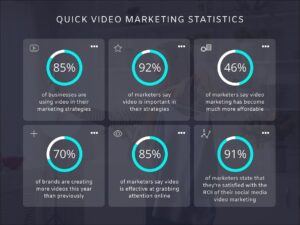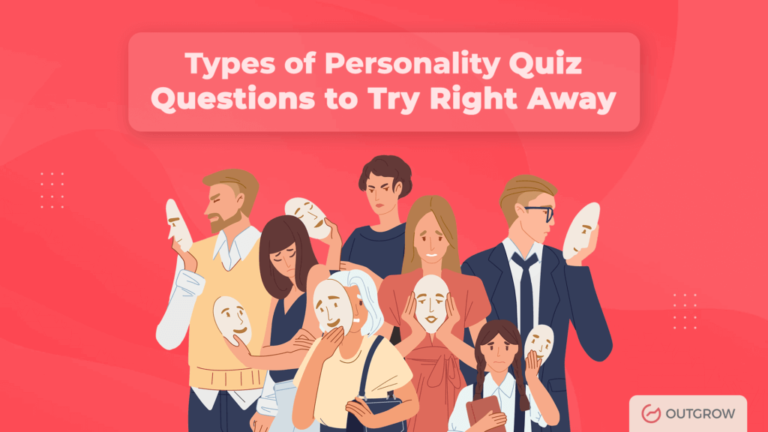How to Develop and Launch a Successful Video Marketing Strategy
Table of Contents
Building a robust video marketing strategy is a powerful way for businesses to engage their audience through visual storytelling. But don’t take our word for it—69% of businesses increased their video marketing budget.
The video has clearly grown as a marketing strategy due to its effectiveness in increasing brand awareness and sales.
But before videos become a successful marketing strategy in your toolbelt, you must learn what it takes to plan, develop, and create videos that leave a lasting mark on your viewers.
In this article, we discuss how to devise a well-planned video marketing strategy to help you get the ball rolling. We’ll also look at examples of video marketing campaigns for inspiration.
But before we begin, let’s define what “video marketing” means.
What Is Video Marketing?
Video marketing is the process of planning, creating, and promoting videos that aim to educate and attract users and market your products. This is done by drawing audiences’ attention to various online channels such as social media, blogs, emails, and others. For video marketing, you need to know how to create a good video intro to make more attractive campaign.
Video marketing benefits you by reaching your target audience in a more dynamic way than text and/or image.
Creating fun and exciting videos using a video editor tool, along with AI voice over, helps business owners achieve their goals and capture customer attention effectively.
Personalization, like interactive elements in videos, can significantly enhance viewer engagement. By using personalized videos, businesses are able to hit milestone goals such as improved client onboarding and increased customer interaction.
(Source)
How to Create an Effective Video Marketing Strategy?
1. Set Goals for Video Marketing
Ask yourself the questions below to lay the groundwork for your strategy. These questions will also help focus your efforts on the areas in your business that your marketing strategy must address:
- What are these videos trying to accomplish? Goals include increasing sign-ups, encouraging people to buy your products, or getting people buzzing about your brand.
- What metrics should I measure to determine the strategy’s success? These include website traffic, number of sign-ups, and total sales over a period.
- How much do I have to spend to get the strategy off the ground? Factors to consider include outsourcing the tasks to someone else, tools to use, and others.
From here, create a video marketing checklist that contains the concrete steps you will take to ensure the success of your campaign.
2. Decide on Your Platform
Narrowing down the platforms where you’ll publish your videos enables you to focus all your energies on those that give you the highest chance of conversions.
To do this, you must identify your target audience.
If you have a business that caters to a younger audience, you’re better off creating videos on Instagram (31% of users are 18-24 years old) and TikTok (the largest age group is 10-19 years old at 25%).
Your choice of platforms also dictates what kind of videos you create. Instagram alone has three categories on its platform, each of which has its ideal lengths: Video (1 minute), Stories (15 seconds), and Reels (15-60 seconds). Consider using an intro maker tool while creating video content.
3. Select Your Video Types
Below are the different video types you must consider creating for your campaign to help you achieve your goals:
- Branded videos – Introduce new products or services, highlight your company culture or provide more information about your business.
- Viral videos – Usually very entertaining and shareable, making them perfect for social video marketing.
- Product demonstrations – Show how your product works, demonstrate its features, and give tips on how to use it in a fun way. If it’s an online product, grab a free screen recorder, or use a tool to create a video collage online, and capture the process to make it easy for viewers to follow along. This will bring engagement and help potential customers better understand the value of your product.
- Personalized videos – Customized for a specific viewer to increase conversion rates.
- Interactive videos – Let you drag, drop, and play around with the elements in the video.
4. Plan Content Production
The next step in your video marketing strategy is to plan for the video’s creation using the information gathered thus far.
First, create a storyboard to help you visualize your video before it’s created.
(Source)
Then, ensure you have all the necessary equipment, book the actors and crew members, and reserve the locations for filming your video. If you plan on doing a big video production with a set and cast members, you must also know any legal requirements you must fulfill before filming the scenes.
If you don’t need to film scenes for your video, go straight to creating the marketing video using your tool of choice.
5. Know What Post-production Entails
Stitch all the scenes together to create the rough cut before editing the audio tracks and adding visual effects. Add the title and end cards, and you’re done!
The steps above cover basic video post-production. More complex videos require more steps and editing skills; be sure to have professionals guide you or hire them to do the job for you. There are also several reliable and affordable unlimited video editing services to help a novice video marketer get their campaign off the ground.
Optimizing your video content, crafted with the best AI video generator, for SEO can significantly enhance your visibility and engagement. Using the best keywords and thumbnails on the video helps increase visibility on platforms like YouTube and boost click-through rates. You can use YouTube rank checker tools to keep track of your performance and find the right optimization steps for your video.
6. Schedule & Promote the Videos
Schedule the video to be published at times when most of your audience or followers are active.
Cross-promote the video on different platforms. Aside from just sharing them on other social media channels, embed them on your website or blog to get more people to view them.
Make sure to edit the videos to the platform’s suggested size and orientation so people can view them properly across all platforms.
Finally, launch paid ads to help spread your video online faster and more efficiently.
7. Understand and Analyze Metrics
Once your video campaign concludes, check to see if it has been able to meet its goals.
Look at the native analytics of the platform where you uploaded the video. It will show you the number of views the video has, the clicks received on the links in the description, and the engagement it got via likes and comments.
If revenue is your video campaign’s primary goal, look at how many visitors your video referred to your landing page. You can then attribute the strategy’s success, which hinges on the number of purchases during that period.
10 Mind-Blowing Video Marketing Strategies Used by Brands
It’s one thing to create a video following the steps above. It’s another to create a video that resonates with modern viewers. Below are several examples of successful, well-executed video marketing campaigns that you can take inspiration from.
1. Coca-Cola: The Last Customer
This video focuses on people who are tirelessly working the night before Christmas. Coca-Cola voices respect for these shopping mall employees who make every holiday possible. The video successfully engages the spirit of the holiday while keeping the brand in the spotlight.
2. Dove: Real Beauty Sketches
The video is an interesting take on how a person sees himself or herself versus how other people see them. It highlights the phenomenon that while everyone is beautiful, they don’t often realize it, as evidenced by the drawings of the FBI forensics expert. Dove strategically used this sentiment to establish their brand image as one that champions inner and outer beauty.
3. Kodiak Cakes: A Frontier & Family Favorite
Kodiak Cakes introduces itself in a fun, engaging way through this video. It identifies the problem (kids not eating healthy breakfast), the solution (pancakes made from whole grains and 14g of protein), and details how to make them. While the campaign ran, viewers could get their 6-pack sampler as the video’s call to action (CTA).
4. Airbnb: Where did Saif & Kareena holiday this summer?
In less than 40 seconds, this video encapsulates what Airbnb is all about. It shows a couple looking for places to stay in London. Using the Airbnb app, they quickly find a place with fun nearby activities unique to the location. The video successfully simulates most people’s problems when booking reservations, and highlights Airbnb as the solution.
5. GoPro: Fireman Saves Kitten
The video shows the power of GoPro as a handy action camera in a meaningful way by communicating the dangers firefighters go through when saving people and animals. The GoPro captures the point of view of firefighters in all its glory.
6. Budweiser: Some Waits For You At Home
Budweiser promotes responsible drinking by shifting the perspective to animals waiting for their owners to arrive. Nobody wants to be left alone, especially pets who need somebody to look after them. While people can still have fun when drinking, they should never drive when drunk so as not to abandon their best friend.
7. Volkswagen’s T-Roc: A perfect day to hit the waves
The video shows a day in the life of Danish National Surfing Team captain Oliver Hartkopp, as he uses the T-Roc, a dynamic and compact SUV, to reach his surfing spot after waking up in the morning. It promotes a specific lifestyle that Volkswagen wants to associate with the T-Roc.
8. Netflix: Interactive Video Example
This interactive marketing video takes you down a rabbit hole of videos based on the decisions you make. It’s reminiscent of the Choose Your Own Adventure books, in which your choices influence the story’s outcome. Readers should take inspiration from this campaign if they plan to launch an ott app.
9. Google Earth: Homeward Bound
People use maps to reach their destinations. With Google Maps, people like Saroo Brierley, who was adopted young enough to barely remember where they came from, can find their way home. It both shows the utility that Google Maps brings to users’ lives and appeals to their emotions by pulling on their heartstrings.
10. Sephora: User Generated
Sephora partnered with YouTube influencer Safia Nygaard to melt 603 of the store’s lipsticks and turn the mixture into 500 lipsticks that will be given away to people who commented on her video. With over 29 million views, the video was a great experiment in engaging the brand’s audience with user-generated content.
Video Marketing Tips You Need to Try
Even if you don’t implement all of the strategies from the video examples above, there’s a thing or two you can learn from each one. Furthermore, use these tips below to help power your video marketing strategy and achieve your campaign goal:
1. Include Catchy CTAs
You want viewers to know what to do next after watching your video. More importantly, you must compellingly present your CTA to mobilize people to act. You can find most calls to action at the end of marketing videos or through a link to a company’s page in the video’s description.
2. Optimize Your Videos With SEO Content
Include your video’s target keywords in its description, tags, URLs, and others. This helps Google associate your content with the keyword you’re targeting and index it high enough on search results that your audience will see it. You can also embed your videos on your blog posts for increased visibility.
3. Play With Interactive Content
The Netflix video example is a branched story type of interactive content you can use for your business. You can implement other interactive content types in your campaign to increase your engagement rates. For instance, you can create quizzes about a topic that interests your audience and is relevant to your products and services. This gives your audience a more proactive role in the campaign instead of just watching or reading something. To get the best results, consider doing a live stream through a video transcoder and engaging with your audience in real-time.
4. Focus on Telling Stories, Not Making Sales
People gravitate towards stories more than simply a description of a product and its benefits. However, the stories must be tied to how the product solves pain points and improves people’s lives. For instance, the Google Maps video shows how the product has improved a customer’s life.
5. Incorporate UGC
You can’t deny the benefits of user-generated content. UGC serves as social proof that increases your audience’s trust in your business. The most common type of UGC is video testimonials. Collect as many positive reviews as possible and stitch them together to showcase this positive feedback on your desired platforms.
6. Collaborate With Brands & Influencers
Similar to UGC, an influencer marketing strategy relies on getting influencers with similar audiences to yours to promote your brand. While influencers have to disclose that your placement in their video is an ad, it is still a great way to promote your brand using your chosen influencers’ voices and personalities.
Conclusion
As you can see, a successful video marketing strategy involves many moving parts. And creating a well-conceptualized video with a clear goal in mind, as seen in the examples above, allows you to elevate your brand to greater heights.
So, what are you waiting for? Follow the process and tips above to get your campaign on the right track. Good luck!

















